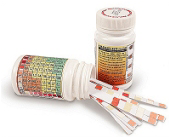Supplemental Coolant Additives (SCA)
Supplemental Coolant Additives are vital for the health and longevity of any diesel engine. Diesels, particularly the Ford Powerstroke, are prone to a problem called cavitation (or liner pitting). Both cavitation and corrosion can result in shorter engine life if the SCA level of your coolant is not monitored and maintained. The proper level of a chemical concentration of 1.5 - 3.0 UPG (Units Per Gallon) should be maintained in your cooling system at all times. For maximum protection be sure you begin with high quality make-up water (test with the ACU5050 CTS-5 Cool Check water test) and then check your SCA level every four months using Acustrip CTS-3 or CTS-4 test strips.
SCA Calculator
You can use the utility below to determine how much SCA to add to your system for the proper level of protection. The recommended level of SCA is 1.5 to 3.0 units per gallon. If you do not check the level frequently you should aim for a higher level such as 2.5 in order to assure that you will not fall below 1.5 over time. Concentrations above 3.0 can result in the buildup of particles that SCAs often cause. This buildup can become loose or flake off the water jacket walls, and because it can be abrasive, it will cause damage to your water pump or even clog certain parts of the cooling system like the heater core.
Too Little SCA
The pistons in your engine move up and down about 2,000 times a minute. While they move vertically, the crankshaft is performing a completely different movement by rotating horizontally. These contradictory movements will cause your engine's liners to vibrate a lot. Although the outer wall of the liner is surrounded by cooling fluid, its inertia creates tiny vacuum pockets, causing bubbles of vapor to form on the liner wall. When the liner vibrates back, these bubbles collapse under an enormous pressure and take small chunks out of the liner. Eventually you will have block failure.
To prevent this, a supplemental coolant additive needs to be added to the cooling system and monitored regularly. Basically a chemical concentration of 1.5 - 3.0 UPG (Units Per Gallon) should be maintained in your cooling system at all times. As a point of reference, a one pint bottle of DCA4 additive is equal to five units. A single unit of SCA raises a single gallon of coolant by one unit. So if you have a five gallon coolant system with an SCA reading of 1.2 and you wish to raise it to 2.2, you would add one pint of SCA to your system. You can use the calculator above to determine how much SCA to add in your particular case.
Too Much SCA
While SCA will protect your system from corrosion and pitting, a lower level will help prevent the buildup of particles that SCAs often cause. This buildup can become loose or flake off the water jacket walls, and because it can be abrasive, it will cause damage to your water pump or even clog certain parts of the cooling system like the heater core. It is recommended to maintain SCA concentrations below 3.0 to avoid this problem (it is best to maintain a lower level and test frequently to maintain a minimum of 1.5). A preventative measure that can be taken to eliminate overly high levels is the use of a coolant filter.



